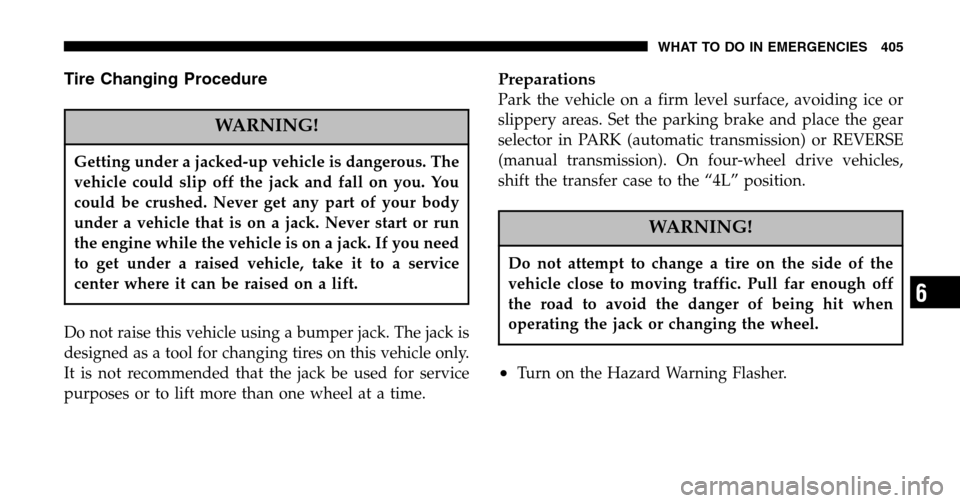DODGE RAM 1500 GAS 2006 3.G Owners Manual
RAM 1500 GAS 2006 3.G
DODGE
DODGE
https://www.carmanualsonline.info/img/12/5489/w960_5489-0.png
DODGE RAM 1500 GAS 2006 3.G Owners Manual
Trending: brake rotor, change language, coolant level, spark plugs replace, low beam, tire size, battery location
Page 401 of 536
Remove the jack and tools by removing the wing bolt and
sliding the assembly from under the seat.
Reinstalling The Scissors-Type Jack And Tools
(1500 Models)
1. Lower the jack all the way down by turning the jack
turn-screw until the jack is snug.
2. Position the jack and tool bag (unrolled). Make sure
the lug wrench is under the jack near the jack turn-screw.
Jack Wing Bolt
Turn Screw and Lug
WHAT TO DO IN EMERGENCIES 401
6
Page 402 of 536
3. Fold the flap and roll the jack tool kit into a cylindrical
package (in direction of arrows), and tie to the jack using
the tie straps.
Folding Flap and Rolling Bag
Tying Bag to Jack with Straps
402 WHAT TO DO IN EMERGENCIES
Page 403 of 536
4. Place the jack and tools in the storage position holding
the jack by the jack turn-screw, slip the jack and tools
under seat so that the bottom slot engages into the
fastener on the floor and then secure to the floor pan
using the wing bolt. Reinstall the plastic cover.CHANGING A FLAT TIRE
Jack and Tools TiedJack Wing Bolt
WHAT TO DO IN EMERGENCIES 403
6
Page 404 of 536
Removing The Spare Tire
Remove the spare tire before attempting to jack the truck.
Attach the wheel wrench to the jack extension tube. Insert
the tube through the access hole between the lower
tailgate and the top of the bumper and into the winch
mechanism tube. Rotate the wheel wrench handle coun-
terclockwise until the spare tire is on the ground with
enough cable slack to allow you to pull it out from under
the vehicle. When the spare is clear, tilt the retainer at the
end of the cable and pull it through the center of the
wheel. It is recommended that you stow the flat or spare to
avoid tangling the loose cable.
NOTE: The winch mechanism is designed for use with
the jack extension tube only. Use of an air wrench or other
power tools is not recommended and can damage the
winch.
404 WHAT TO DO IN EMERGENCIES
Page 405 of 536

Tire Changing Procedure
WARNING!
Getting under a jacked-up vehicle is dangerous. The
vehicle could slip off the jack and fall on you. You
could be crushed. Never get any part of your body
under a vehicle that is on a jack. Never start or run
the engine while the vehicle is on a jack. If you need
to get under a raised vehicle, take it to a service
center where it can be raised on a lift.
Do not raise this vehicle using a bumper jack. The jack is
designed as a tool for changing tires on this vehicle only.
It is not recommended that the jack be used for service
purposes or to lift more than one wheel at a time.
Preparations
Park the vehicle on a firm level surface, avoiding ice or
slippery areas. Set the parking brake and place the gear
selector in PARK (automatic transmission) or REVERSE
(manual transmission). On four-wheel drive vehicles,
shift the transfer case to the “4L” position.
WARNING!
Do not attempt to change a tire on the side of the
vehicle close to moving traffic. Pull far enough off
the road to avoid the danger of being hit when
operating the jack or changing the wheel.
•Turn on the Hazard Warning Flasher.
WHAT TO DO IN EMERGENCIES 405
6
Page 406 of 536
•Block both the front and rear
of the wheel diagonally oppo-
site the jacking position. For
example, if the right front
wheel is being changed, block
the left rear wheel.
•Passengers should not remain in the vehicle when the
vehicle is being jacked.
Instructions
WARNING!
Carefully follow these tire changing warnings to help
prevent personal injury or damage to your vehicle:
•Always park on a firm, level surface as far from the
edge of the roadway as possible before raising the
vehicle.
•Block the wheel diagonally opposite the wheel to be
raised.
•Apply the parking brake firmly before jacking.
•Never start the engine with the vehicle on a jack.
•Do not let anyone sit in the vehicle when it is on a
jack.
•Do not get under the vehicle when it is on a jack.
•Only use the jack in the positions indicated.
•If working on or near a roadway, be extremely
careful of motor traffic.
406 WHAT TO DO IN EMERGENCIES
Page 407 of 536
1. Remove the spare wheel, jack, and tools from storage.
2. Using the wheel wrench, loosen, but do not remove,
the wheel nuts by turning them counterclockwise one
turn while the wheel is still on the ground.
3. Placement of the Jack:
•For 1500 series trucks, when changing a front wheel,
place the scissors jack under the rear portion of the
lower control arm as shown below.
1500 4X2 Jacking Location
WHAT TO DO IN EMERGENCIES 407
6
Page 408 of 536
•For 2500/3500 4x2 series trucks, when changing a
front wheel, place the bottle jack under the frame
rail behind the wheel. Locate the jack as far forward
as possible on the straight part of the frame.•Operate the jack using the jack drive tube and the
wheel wrench. The tube extension, may be used, but
is not required.
•For 2500/3500 4x4 series trucks, when changing the
front wheel, assemble the jack drive tube to the jack
and connect the drive tube to the extension tube.
1500 4X4 Jacking Location2500/3500 4X2 Jacking
408 WHAT TO DO IN EMERGENCIES
Page 409 of 536
Place the jack under the axle as close to the tire as
possible with the drive tubes extending to the front.
Connect the jack tube extension and wheel wrench.
•For all trucks, when changing a rear wheel, as-
semble the jack drive tube to the jack and connect
the drive tube to the extension tube. Place the jack under the axle between the spring and the shock
absorber with the drive tubes extending to the rear.•Connect the jack tube extension and wheel wrench.
Before raising the wheel off the ground, make sure
that the jack will not damage surrounding truck
parts and adjust the jack position as required.
Rear Jacking Location (All)
WHAT TO DO IN EMERGENCIES 409
6
Page 410 of 536

NOTE:If the 2500/3500 bottle jack will not lower by
turning the dial (thumb wheel) by hand, it may be
necessary to use the jack drive tube in order to lower the
jack.
4. By rotating the wheel wrench clockwise, raise the
vehicle until the wheel just clears the surface.
WARNING!
Raising the vehicle higher than necessary can make
the vehicle unstable and cause an accident. It could
slip off the jack and hurt someone near it. Raise the
vehicle only enough to remove the tire.
5. Remove the wheel nuts and pull the wheel off. Install
the spare wheel and wheel nuts with the cone shaped end
of the nuts toward the wheel on 1500/2500/3500 single
rear wheel (SRW) models. On 3500 dual rear wheel models (DRW) the lug nuts are a two piece assembly
with a flat face. Lightly tighten the nuts. To avoid risk of
forcing the vehicle off the jack, do not fully tighten the
nuts until the vehicle has been lowered.
6. Using the wheel wrench, finish tightening the nuts
using a crisscross pattern. Correct nut tightness is 135 ft.
lbs. (183 N·m) torque for 1500/2500/3500 single rear
wheel (SRW) models and 145 ft. lbs. (197 N·m) for 3500
dual rear wheel models. If in doubt about the correct
tightness, have them checked with a torque wrench by
your dealer or at a service station.
410 WHAT TO DO IN EMERGENCIES
Trending: headlights, trailer, ignition, ECO mode, child restraint, garage door opener, fuel reserve









